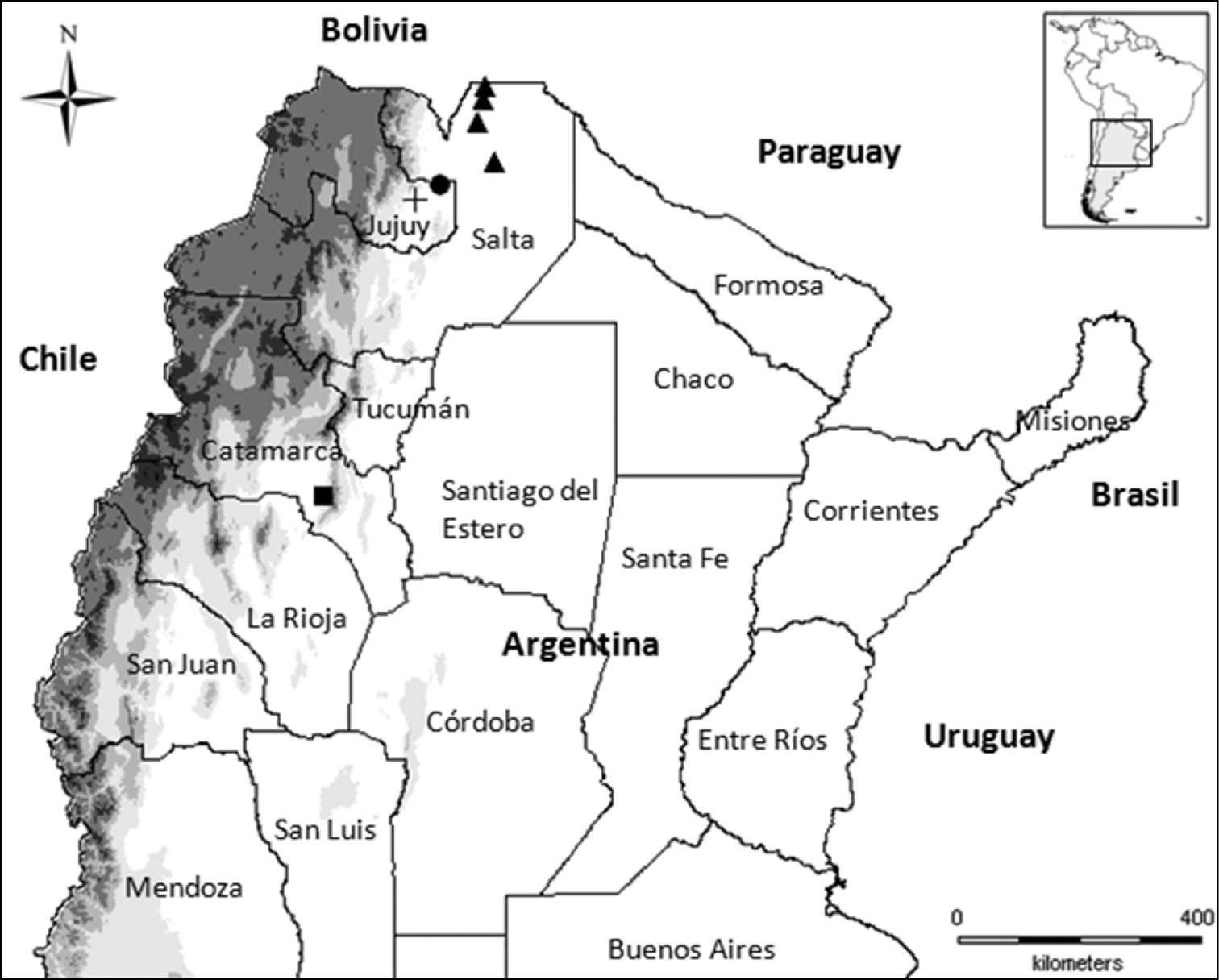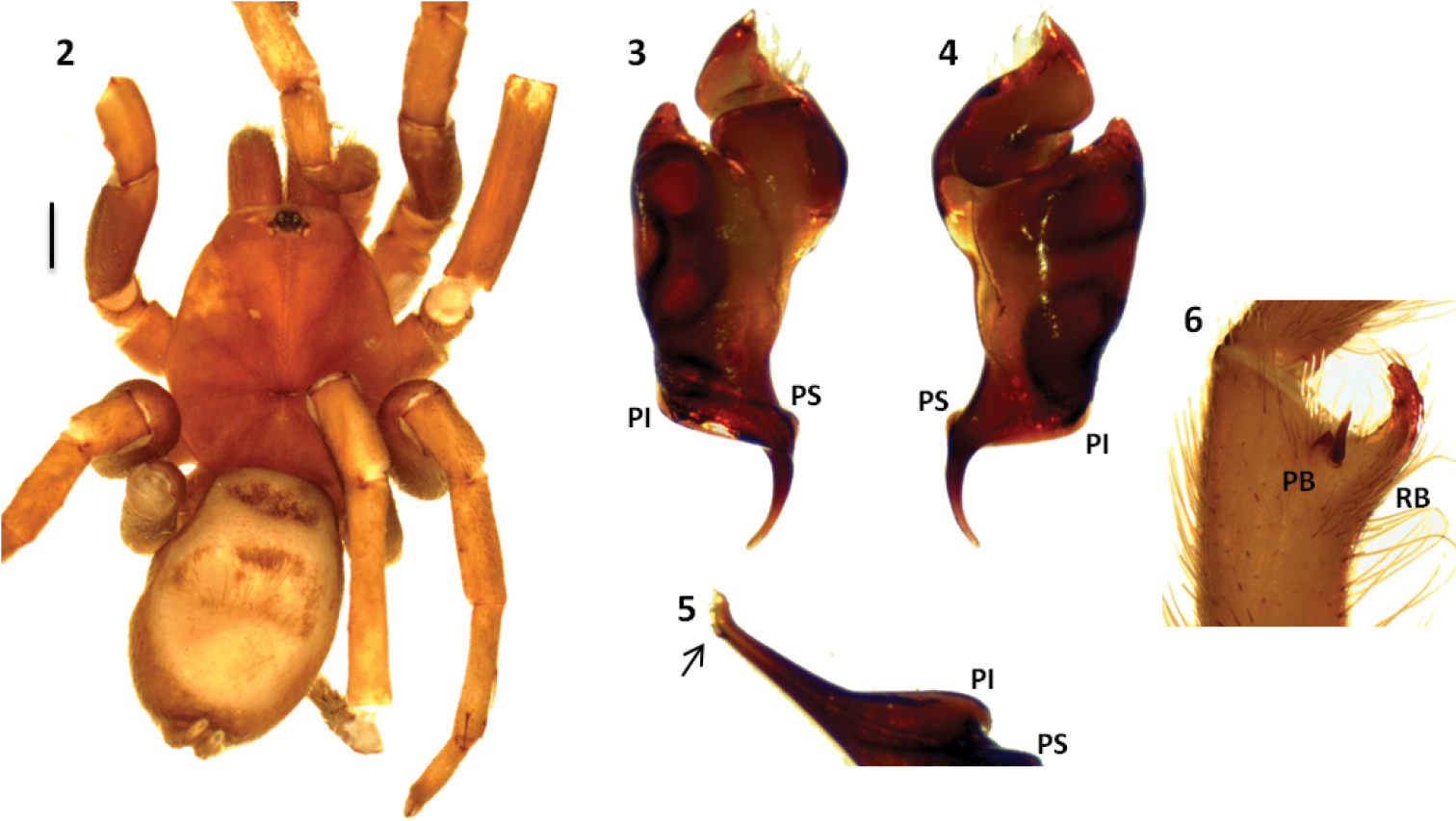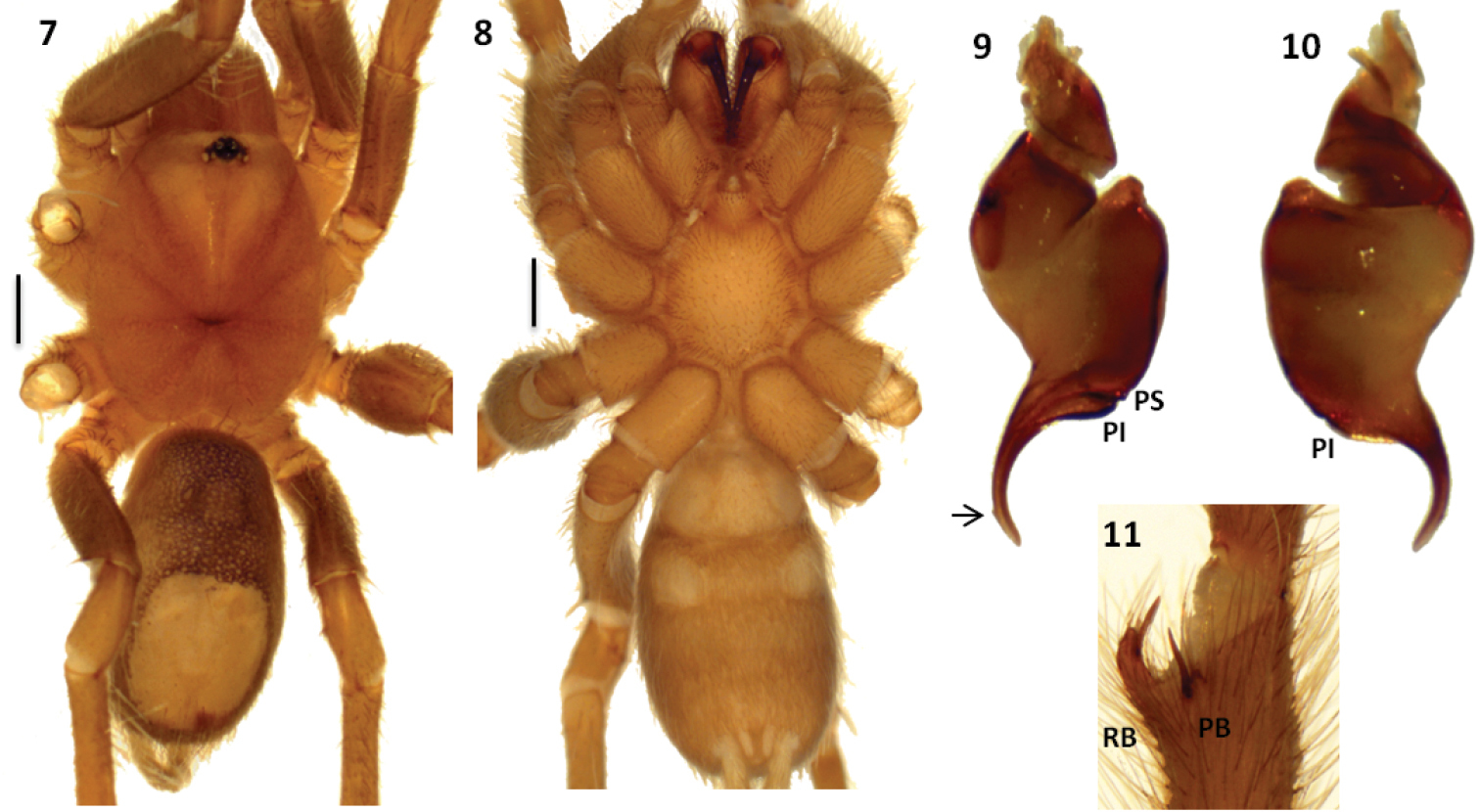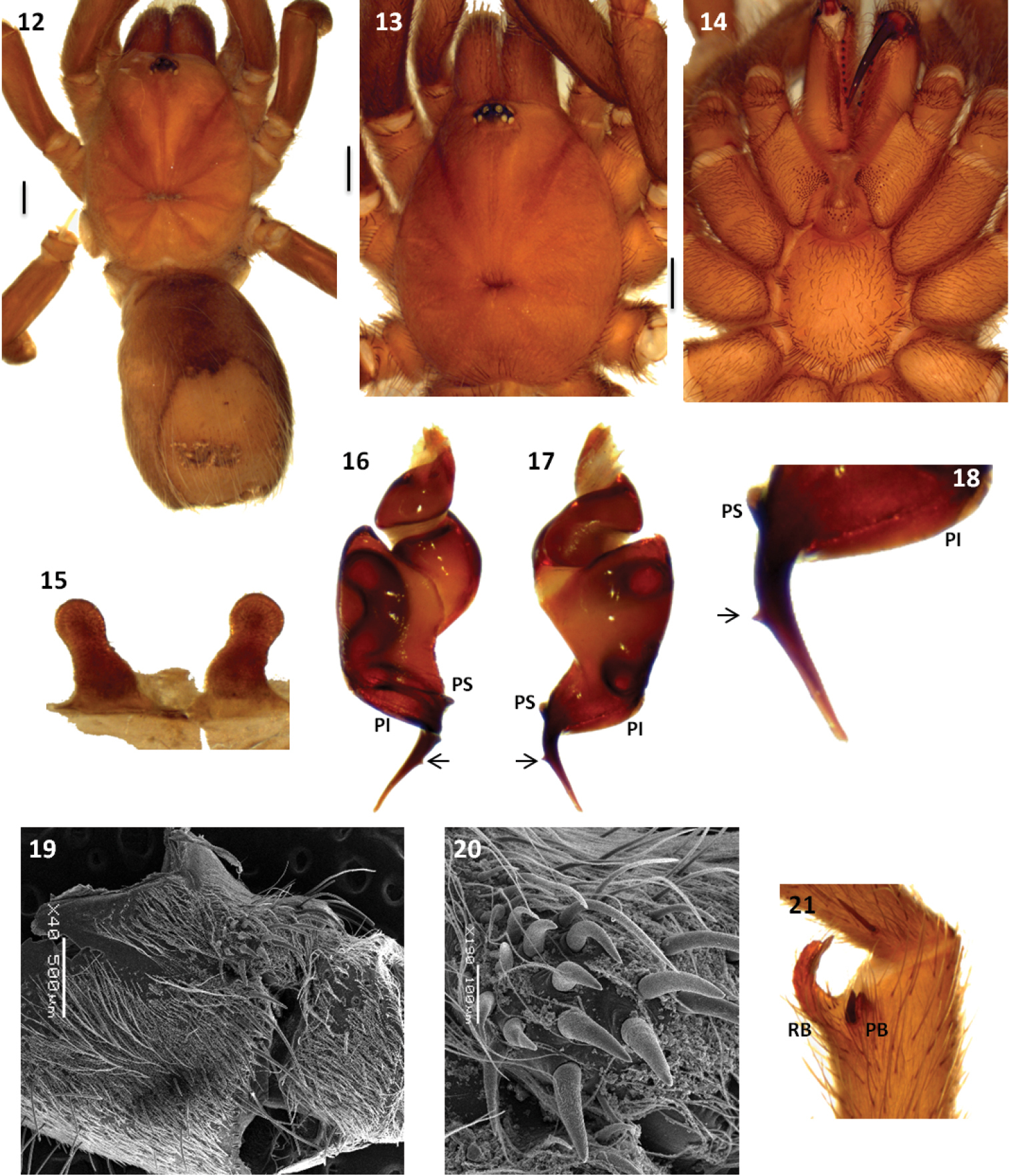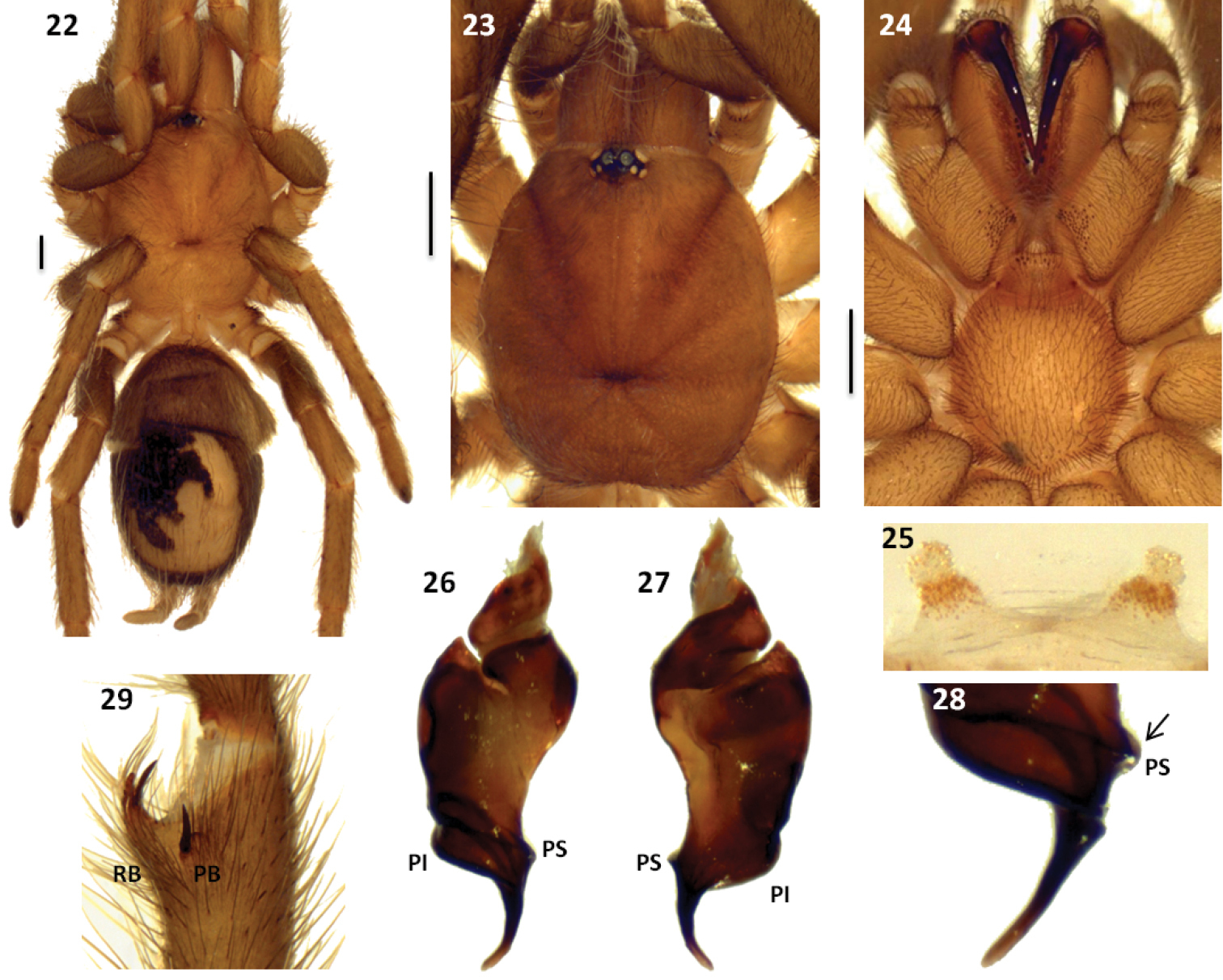






Citation: Perafán C, Pérez-Miles F (2014) Three new species of Melloleitaoina Gerschman & Schiapelli, 1960 (Araneae, Mygalomorphae, Theraphosidae) from northern Argentina. ZooKeys 404: 117–129. doi: 10.3897/zookeys.404.6243
Three new species of the monotypic genus Melloleitaoina Gerschman & Schiapelli, 1960 are described from northern Argentina: M. mutquina sp. n., M. uru sp. n. and M. yupanqui sp. n. The female specimen originally described as M. crassifemur is not conspecific with the male holotype and thus is removed from this species and described as M. uru sp. n.; M. crassifemur is redescribed. All species are diagnosed, illustrated and a key to species is provided.
Tarantula, taxonomy, Theraphosinae
The subfamily Theraphosinae (Theraphosidae) is a speciose group of tarantulas distributed exclusively in the New World, whose greatest diversity is found in South America. Most tarantulas have cryptic habits, are predominantly nocturnal sit-and-wait hunters and have long lifespans. Females can live between 15 and 30 years while males live for significantly shorter periods of time (
The monotypic genus Melloleitaoina was established by
Melloleitaoina is characterized by having a reduced number of labial cuspules, legs with few spines, all tarsal scopulae divided and lacking scopulae on metatarsal IV. Males have a thickened femur III, palpal organ with a long and curved embolus, and tibial apophysis with two very unequal branches. Females have spermathecae with two granulated seminal receptacles with a slight constriction near the apex (
Our study of the types and additional material deposited in the Museo Argentino de Ciencias Naturales “Bernardino Rivadavia”, led us to determine that the female of Melloleitaoina crassifemur is not conspecific with male holotype when contrasted with males from the same locality of the female. Also we found other individuals that fit with the diagnosis of the genus but are undescribed; they are described as new species herein.
Urticating setae terminology follows
The following abbreviations are used: ALE = anterior lateral eyes; AME = anterior median eyes; OQ = ocular quadrangle (including lateral eyes); p = prolateral; PB = prolateral branch of tibial apophysis; PI = prolateral inferior keel; PME = posterior median eyes; PMS = posteromedial spinnerets; PLE = posterior lateral eyes; PLS = posterolateral spinnerets; PS = prolateral superior keel; r = retrolateral; RB = retrolateral branch of tibial apophysis.
Melloleitaoina crassifemur Gerschman & Schiapelli, 1960
Both sexes have a reduced number of labial cuspules (6–14), all tarsal scopulae divided and metatarsal IV scopulae absent. Males differ from other Theraphosinae by having a thickened femur III, palpal organ with a long and curved embolus with two prolateral keels (PI and PS) (Figs 3–4, 9–10, 16–17 and 26–27), and tibial apophysis with two very unequal branches (Figs 6, 11, 21 and 29). Females differ from other Theraphosinae by having spermathecae with two granulated seminal receptacles with a slight constriction near the apex (Figs 15 and 25) and spiniform setae on promargin of coxae III and IV (Figs 19 and 20). Females have type IV urticating setae while males have III-IV intermediated urticating setae.
Melloleitaoina species share with Plesiopelma Pocock, 1901 and Tmesiphantes Simon, 1892, principally by the general morphology of the palpal bulb and tibial apophysis. Melloleitaoina males can be distinguished additionally from those of Plesiopelma by lacking nodule on metatarsi I and having only III-IV intermediated urticating setae. They can be distinguished from Tmesiphantes by having sigillas more rounded, male femur III incrassate and female spermathecae with granulated seminal receptacles and spiniform setae on promargin of coxae III and IV.
Northern Argentina. Catamarca, Salta and Jujuy provinces (Fig. 1).
Map of Northern Argentina, geographical distribution of the Melloleitaoina species. Melloleitaoina uru (triangles); Melloleitaoina crassifemur (circle); Melloleitaoina yupanqui (cross); Melloleitaoina mutquina (square).
http://species-id.net/wiki/Melloleitaoina_crassifemur
Figs 2–6Only type material.
Holotype male from Argentina, Salta, Orán, Urundel, 335m above sea level, 23°33'0"S, 64°25'0"W, viii-1947, Misión Ricardo N. Orfila leg. (MACN-Ar 2285).
Male differs from other Melloleitaoina species by the palpal bulb morphology with very curved embolus without triangular tooth, well-developed and subequal PI and PS (Figs 3 and 4), and apex widened (Fig. 5). Females unknown.
Melloleitaoina crassifemur. 2 male holotype, dorsal view 3–5 left palpal bulb, 3 prolateral view 4 retrolateral view 5 detail of apex widened 6 left tibial apophysis (subapical spine on retrolateral branch RB lost). Scale bar = 1 mm.
Holotype male (MACN-Ar 2285): total length, not including chelicerae or spinnerets, 14.1, carapace length 5.9, width 5.3. Color (in alcohol): cephalotorax, legs light brown, abdomen grayish brown. Anterior eye row slightly procurved, posterior recurved. Eyes and interdistances: AME 0.18, ALE 0.30, PME 0.14, AME-ALE 0.06, PME-PME 0.38, PME-PLE 0.04, ALE-PLE 0.08, AME-PME 0.04, ALE-ALE 0.40. OQ length 0.50, width 0.96, clypeus 0.14. Fovea transverse, procurved, width 0.70. Chelicerae with 10/12 well-developed teeth on furrow promargin, few small teeth on the proximal area of furrow. Labium length 0.68, width 1.07 with 7 cuspules. Maxillae with 74 cuspules. Sternum length 2.70, width 2.70. Tarsi I-IV scopula widely divided, by conical setae thicker and longer. Tarsal claws with 2-3 small teeth on proximal half, near the inner edge. Sparse scopulae on metatarsi; metatarsi I-III apically scopulate, IV without scopula. Tibia I with prolatero-ventral distal apophysis with two very unequal branches (Fig. 6); PB subtriangular, small, with basal curved spine, much longer than branch, RB curved, much larger than PB with internal medial spine that exceeds length of branch. Metatarsus I slightly curved, flexion on RB. Femur III very thickened. Type III-IV intermediate urticating setae present. PMS well-developed, PLS normal, apical segment digitiform. Palpal organ piriform with the embolus very curved, two prolateral keels (PI and PS) present, subequal, apex widened (Figs 3–5).
Spination. Femora: palp, I-IV 0. Patellae: palp, I-IV 0. Tibiae: palp 0, I 0, II 1P, III 2V, 1P, 2R, IV 1R. Metatarsi: I 1V, II 1V, III 3V, 2P, IV 4V, 2P, 1R. Tarsi: palp, I-IV 0.
Legs and palpal segments lengths (femur/patella/tibia/metatarsus/tarsus). Palp: 3.1/2.0/2.5/1.2 total 8.8; I: 5.5/3.5/4.4/3.8/2.4 total 19.6; II: 4.9/1.9/3.6/4.4/2.3 total 17.1; III: 3.5/2.0/2.8/3.7/2.2 total 14.2; IV: 6.0/2.2/5.0/6.3/2.5 total 22.
The female Melloleitaoina crassifemur was described thirteen years after the original description of the male holotype of the species. This female specimen was assigned as Melloleitaoina crassifemur because it was collected near the male type locality. We examined male specimens from the same locality of this female and found important morphological differences between these males and the holotype Melloleitaoina crassifemur, as the palpal bulb shape, the presence of a conspicuous triangular tooth on the embolus (Figs 16 and 17) and the spiniform setae on coxae III and IV (Figs 19–21), also it present on the female. Taking into account that these new males are sympatric with the female attributed to Melloleitaoina crassifemur we considered them as conspecific, and are here described as a new species.
http://zoobank.org/ECCA9985-CFAE-4CBE-98EE-30154F1CD4E6
http://species-id.net/wiki/Melloleitaoina_mutquina
Figs 7–11Known only from types.
Holotype male from Argentina, Catamarca, Mutquín, 1500m above sea level, 28°19'0"S, 66°10'0"W, 2-ii-1981, E. Maury leg. (MACN-Ar 7737).
Male differs from other Melloleitaoina species by the palpal bulb morphology with the embolus less curved, absence of triangular tooth, PS very flat and apex widened (Figs 9 and 10). Females unknown.
Melloleitaoina mutquina. 7–8 male holotype 7 dorsal view 8 ventral view 9–10 right palpal bulb 9 prolateral view 10 retrolateral view 11 right tibial apophysis. Arrow indicates apex widened. Scale bars = 1 mm.
Holotype male (MACN-Ar 7737): total length, not including chelicerae or spinnerets, 9.4, carapace length 4.1, width 3.7. Color (in alcohol): cephalotorax, legs light reddish brown, cephalotorax with few brown and golden setae, abdomen brown with a patch of urticating setae golden brown. Anterior eye row procurved, posterior slightly recurved. Eyes and interdistances: AME 0.15, ALE 0.20, PME 0.11, PLE 0.15, AME-AME 0.11, AME-ALE 0.066, PME-PME 0.33, PME-PLE 0.022, ALE-PLE 0.077, AME-PME 0.055, ALE-ALE 0.40. OQ length 0.68, width 0.61, clypeus 0.022. Fovea transverse, procurved, width 0.66. Chelicerae with 10/9 well-developed teeth on furrow promargin, 5/3 small teeth on the proximal area of furrow. Labium length 0.48, width 0.78, with 6 cuspules. Maxillae with 38/39 cuspules. Sternum length 1.9, width 1.9. Tarsi I-IV scopula widely divided. Tarsal claws with 1-4 small teeth on proximal half, ventral midline. Sparse scopulae on metatarsi; metatarsus I scopulate on distal third, II apically, III and IV without scopula. Tibia I with prolatero-ventral distal apophysis with two very unequal branches (Fig. 11); PB subtriangular, small, with basal curved spine, much longer than branch, RB curved, around ten times bigger than PB with internal medial spine that exceeds length of branch. Metatarsus I slightly curved, flexion on RB. Femur III thickened. Type III-IV intermediate urticating setae present. Palpal organ piriform with the embolus slightly curved, two prolateral keels (PI and PS) present, PS very flat, apex widened (Figs 9 and 10).
Spination. Femora: palp 0; I 0; II 0; III 0; IV 0. Patellae: palp 0; I 0; II 0; III 0; IV 0. Tibiae: palp 0; I 0; II 1P; III 1V, 1P; IV 1V, 1P, 1R. Metatarsi: I 1V; II 1V; III 3V, 2P; IV 4V, 1P. Tarsi: palp, I-IV 0.
Legs and palpal segments lengths (femur/patella/tibia/metatarsus/tarsus). Palp: 2.2/1.3/1.5/0.8 total 5.8; I: 3.5/2.0/2.9/2.1/1.4 total 11.9; II: 3.0/1.7/2.3/2.1/1.4 total 10.5; III: 2.7/1.4/1.8/2.3/1.4 total 9.6; IV: 3.8/1.7/3.0/4.0/1.8 total 14.3.
The specific epithet mutquina is a noun taken in apposition and means place or thing to smell in Quichua language and refers to the locality of Mutquín, where this species is distributed. It denotes the aroma of the flora of the region that emerges especially after rains, perfuming the village of aromatics herbs.
http://zoobank.org/60708C57-F159-46CC-9EB3-3FFCEEA3FE7A
http://species-id.net/wiki/Melloleitaoina_uru
Figs 12–21Type material. Holotype male from Argentina, Salta, 37, 5 Km O. Hickmann, 235m above sea level, 23°11'60"S, 63°34'0"W, Goloboff, Coyle, Bennet leg. (MACN-Ar 26042). Paratypes: female from Argentina, Salta, Aguaray, Punilla, 570m above sea level, 22°16'0"S, 63°43'60"W, iv-1948, Biraben leg. (MACN-Ar 6542); 2 males and 1 female, with the same data (MACN-Ar 6543); male from Argentina, Salta, Campamento Vespucio, 450m above sea level, 22°36'0"S, 63°49'0"W, 10-13-v-1988, Goloboff leg. (MACN-Ar 26043); 2 females from Argentina, Salta, Pocitos (Salvador Mazza), 800m above sea level, 22°4'0"S, 63°43'0"W, xi-1951; Biraben leg. (MACN-Ar 6544).
Other material. Juvenile from Argentina, Salta, Aguaray, Punilla, 22°16'0"S, 63°43'60"W, iv-1948, Biraben leg. (MACN-Ar 6542); 3 juveniles from Argentina, Salta, Pocitos (Salvador Mazza), 22°4'0"S, 63°43'0"W, xi-1951; Biraben leg. (MACN-Ar 6544).
Males differ from other Melloleitoina species by the palpal bulb morphology with very curved embolus with a conspicuous subapical triangular tooth and well-developed PI and PS (Figs 16–18). Females differ from other Melloleitaoina species by the shape of the spermathecae with elongated seminal receptacles with small granules (Fig. 15).
Melloleitaoina uru. 12 female, dorsal view 13–14 male holotype 13 cephalotorax 14 sternum, labium, maxillae and quelicerae 15 spermathecae 16–18 left palpal bulb 16 prolateral view 17 retrolateral view 18 detail of triangular tooth on embolus 19–20 coxa III 19 prolateral view 20 detail of spiniform setae 21 right tibial apophysis. Arrow indicates triangular tooth on embolus. Scale bars black = 1 mm.
Holotype male (MACN-Ar 26042): total length, not including chelicerae or spinnerets, 13.8, carapace length 6.5, width 5.5. Color (in alcohol): cephalotorax, legs clear reddish brown, cephalotorax with few brown and golden setae, abdomen brown with a patch urticating setae golden brown. Anterior eye row slightly procurved, posterior slightly recurved. Eyes and interdistances: AME 0.17, ALE 0.27, PME 0.17, PLE 0.22, AME-AME 0.12, AME-ALE 0.06, PME-PME 0.43, PME-PLE 0.025, ALE-PLE 0.06, AME-PME 0.075, ALE-ALE 0.50. OQ length 0.97, width 0.72, clypeus 0.025. Fovea transverse, procurved, width 0.75. Chelicerae with 8 well-developed teeth on furrow promargin, 12/14 small teeth on the proximal area of furrow. Labium length 0.57, width 1.45, with 11 cuspules. Maxillae with 109/114 cuspules. Sternum length 2.6, width 2.6. Coxae III and IV with spiniform setae on promargin (Figs 19–20). Tarsi I-IV scopula widely divided. Tarsal claws with 3 small teeth on proximal half, ventral midline. Sparse scopulae on metatarsi; metatarsus I scopulate on distal half, II on distal third, III apically, IV without scopula. Tibia I with prolatero-ventral distal apophysis with two very unequal branches (Fig. 21); PB subtriangular, small, with basal spine, similar size to the branch, RB curved, at least five times bigger than PB with internal medial spine that exceeds length of branch. Metatarsus I slightly curved, flexion on RB. Femur III thickened. Type III-IV intermediate urticating setae present. Palpal organ piriform with the embolus very curved and with a conspicuous subapical triangular tooth, two prolateral keels (PI and PS) present, subequal (Figs 16–18).
Spination. Femora: palp 1P; I 1P; II 1P; III 1P, 1R; IV 1R. Patellae: palp 0; I 0; II 0; III 1P; IV 0. Tibiae: palp 2P; I 2V, 1P; II 3V, 1P; III 7V, 2P, 2R; IV 7V, 2P, 3R. Metatarsi: I 2V, 1P; II 2V, 1P; III 9V, 3P, 2R; IV 10V, 3P, 3R. Tarsi: palp, I-IV 0.
Legs and palpal segments lengths (femur/patella/tibia/metatarsus/tarsus). Palp: 3.2/2.0/2.7/1.1 total 9.0; I: 5.3/2.7/4.0/3.6/2.3 total 17.9; II: 4.7/2.4/3.3/3.2/2.1 total 15.7; III: 3.9/1.9/2.5/3.7/2.1 total 14.1; IV: 5.9/2.4/5.0/6.6/2.3 total 22.2.
Paratype female (MACN-Ar 6542): total length, not including chelicerae or spinnerets, 14.8, carapace length 6.6, width 5.7. Color (in alcohol): as in male. Anterior eye row slightly procurved, posterior slightly recurved. Eyes and interdistances: AME 0.17, ALE 0.31, PME 0.17, PLE 0.25, AME-AME 0.15, AME-ALE 0.06, PME-PME 0.4, PME-PLE 0.025, ALE-PLE 0.075, AME-PME 0.10, ALE-ALE 0.56. OQ length 1.02, width 0.95, clypeus 0.025. Fovea transverse, procurved, width 1.12. Chelicerae with 10 well-developed teeth on furrow promargin, 12 small teeth on the proximal area of furrow. Labium length 0.62, width 1.42, with 6 cuspules. Maxillae with 96/89 cuspules. Sternum length 2.9, width 2.9. Coxae III and IV with spiniform setae on promargin (Figs 19–20). Tarsi palp, I-IV scopula widely divided. Tarsal claws with 3 small teeth on proximal half, ventral midline. Sparse scopulae on metatarsi; metatarsus I scopulate on distal half, II on distal third, III and IV without scopula. Type IV urticating setae present. Spermathecae with two elongated seminal receptacles with small granules (Fig. 15).
Spination. Femora: palp 0; I 0; II 1P; III 1P, 1R; IV 0. Patellae: palp 0; I 0; II 0; III 1P; IV 0. Tibiae: palp 3V; I 0; II 0; III 4V, 3P, 1R; IV 7V, 3P, 2R. Metatarsi: I 2V; II 3V; III 6V, 3P, 2R; IV 10V, 3P, 3R. Tarsi: palp, I-IV 0.
Legs and palpal segments lengths (femur/patella/tibia/metatarsus/tarsus). Palp: 3.2/2.4/2.0/2.1 total 9.7; I: 4.0/2.5/3.0/2.4/1.5 total 13.4; II: 3.8/2.5/2.7/2.4/1.6 total 13.0; III: 3.2/2.4/2.0/3.0/1.6 total 12.2; IV: 4.7/2.6/4.0/5.0/2.0 total 18.3.
Males and females total length 9.2-16.5. Labium cuspules 6-14.
The specific epithet is a noun taken in apposition and refers to an ancient legend Quichua, from the northern limit of Argentina, about the princess Inca Uru, who by their whims and bad government was transformed by the gods into a spider and forced to endlessly work weaving.
http://zoobank.org/3BD376C4-CA74-4A6A-8D2F-99445C54587E
http://species-id.net/wiki/Melloleitaoina_yupanqui
Figs 22–29Known only from types.
Holotype male from Argentina, Jujuy, P. Nacional Calilegua, Seccional Aguas Negras, 605m above sea level (GPS), 23°45'43.3"S, 64°51'04.7"W (± 10m, WGS84), 06-11-xii-2008, C. Grismado, M. Izquierdo, F. Labarque, G. Rubio, M. Burger, P. Michalik, P. Carrera, A. Ojanguren and C. Mattoni leg. (MAC-Ar 26041). Paratype female, same data as the holotype (MAC-Ar 26044).
Male differs from other Melloleitaoina species by the palpal bulb morphology with a discontinuous PS, formed by two separate keels, very curved embolus without triangular tooth, well-developed PI and PS, and apex widened (Figs 26 and 28). Female differs from other Melloleitaoina species by the shape of the spermathecae with short seminal receptacles with large granules (Fig. 25).
Melloleitaoina yupanqui. 22 female, dorsal view 23–24 male holotype 23 cephalothorax 24 sternum, labium, maxillae and quelicerae 25 spermathecae 26–28 left palpal bulb 26 prolateral view 27 retrolateral view 28 detail of embolus showing PS discontinuous 29 right tibial apophysis. Scale bars = 1 mm.
Holotype male (MAC-Ar 26041): total length, not including chelicerae or spinnerets, 9.3, carapace length 4.3, width 4.0. Color (in alcohol): cephalotorax, legs light reddish brown, cephalotorax with few brown and golden setae, legs darker, mainly femora, abdomen brown with a patch of urticating setae golden brown. Anterior eye row slightly procurved, posterior slightly recurved. Eyes and interdistances: AME 0.17, ALE 0.22, PME 0.12, PLE 0.16, AME-AME 0.088, AME-ALE 0.033, PME-PME 0.36, PME-PLE 0.022, ALE-PLE 0.055, AME-PME 0.022, ALE-ALE 0.39. OQ length 0.75, width 0.55, clypeus 0.022. Fovea transverse, procurved, width 0.68. Chelicerae with 11 well-developed teeth on furrow promargin, 8/10 small teeth on the proximal area of furrow. Labium length 0.48, width 0.88, with 8 cuspules. Maxillae with 53/51 cuspules. Sternum length 2.0, width 2.0. Tarsi I-IV scopula widely divided. Tarsal claws with 2 small teeth on proximal half, near the inner edge. Sparse scopulae on metatarsi; metatarsus I scopulate on distal half, II scopulate on distal third, III only apically scopulate, IV without scopula. Tibia I with prolatero-ventral distal apophysis with two very unequal branches (Fig. 29); PB very short with basal spine, much longer than branch, RB curved, around ten times bigger than PB with internal medial spine that exceeds the length of branch. Metatarsus I slightly curved, flexion on RB. Femur III thickened. Type III-IV intermediate urticating setae present. Palpal organ piriform with the embolus very curved, two prolateral keels (PI and PS) present, discontinuous PS, formed by two keels, apex widened (Figs 26–28).
Spination. Femora: 0. Patellae: 0. Tibiae: palp 0; I 1P; II 0; III 2V, 2P, 1R; IV 4V, 2R. Metatarsi: I 1V; II 1V; III 6V, 3P, 1R; IV 8V, 1P, 2R. Tarsi: palp, I-IV 0.
Legs and palpal segments lengths (femur/patella/tibia/metatarsus/tarsus). Palp: 2.4/1.3/1.9/0.7 total 6.3; I: 3.9/2.2/3.3/2.7/1.7 total 13.8; II: 3.6/2.0/2.6/2.4/1.7 total 12.3; III: 2.9/1.4/1.8/2.5/1.6 total 10.2; IV: 4.6/1.7/3.6/4.9/2.2 total 17.0.
Paratype female (MAC-Ar 26044): total length, not including chelicerae or spinnerets, 10.6, carapace length 4.9, width 4.0. Color (in alcohol): as in male, but lighter. Anterior eye row slightly procurved, posterior slightly recurved. Eyes and interdistances: AME 0.17, ALE 0.31, PME 0.19, PLE 0.21, AME-AME 0.08, AME-ALE 0.04, PME-PME 0.31, PME-PLE 0.022, ALE-PLE 0.044, AME-PME 0.066, ALE-ALE 0.39. OQ length 0.81, width 0.66, clypeus 0.022. Fovea transverse, procurved, width 0.71. Chelicerae with 9 well-developed teeth on furrow promargin, 15/14 small teeth on the proximal area of furrow. Labium length 0.55, width 1.1, with 8 cuspules. Maxillae with 90/87 cuspules. Sternum length 2.1, width 2.1. Coxae III and IV with spiniform setae on promargin (as Figs 19 and 20). Tarsi palp, I-IV scopula widely divided. Tarsal claws with 2 small teeth on proximal half, near the inner edge. Sparse scopulae on metatarsi; metatarsus I scopulate on distal half, II on distal third, III and IV without scopula. Type IV urticating setae present. Spermathecae with two short seminal receptacles with large granules (Fig. 25).
Spination. Femora: palp 1P; I 1P; II 1P; III 1P, 1R; IV 0. Patellae: palp 0; I 0; II 0; III 1P; IV 0. Tibiae: palp 4V; I0; II 0; III 5V, 2P, 2R; IV 5V, 2R. Metatarsi: I 2V; II 2V; III 9V, 3P, 2R; IV 7V, 2P, 2R. Tarsi: palp, I-IV 0.
Legs and palpal segments lengths (femur/patella/tibia/metatarsus/tarsus). Palp: 2.5/1.6/1.7/1.6 total 7.4; I: 3.3/2.2/2.5/1.8/1.4 total length 11.2; II: 2.9/1.9/2.0/1.7/1.4 total 9.9; III: 2.6/1.5/1.7/2.3/1.4 total 9.5; IV: 3.7/1.7/2.8/3.3/1.7 total 13.2.
The specific epithet is a patronym in honor to the most important Argentine musician of folklore Atahualpa Yupanqui, pseudonym of Héctor Roberto Chavero Aramburu (Juan A. de la Peña, Argentina, 1908 – Nimes, Francia, 1992).
| 1 | Palpal bulb with a triangular tooth on the embolus (Figs 16–18) | Melloleitaoina uru |
| – | Palpal bulb without a triangular tooth on the embolus | 2 |
| 2 | Embolus slightly curved and very flat PS (Figs 9 and 10) | Melloleitaoina mutquina |
| – | Embolus very curved and well developed PS | 3 |
| 3 | Embolus with continues PS (Figs 3 and 4) | Melloleitaoina crassifemur |
| Embolus with discontinous PS (Figs 26–28) | Melloleitaoina yupanqui |
We would like to thank Martín Ramírez and Cristian Grismado from the Museo Argentino de Ciencias Naturales “Bernardino Rivadavia” for lending us all specimens reviewed and for his collaboration. Thanks to referees for the careful work and valuable comments. The author (C.P.) wants to thank CSIC, Universidad de la República, Uruguay, for the financial support (CSIC C 311/102). Open access to this paper was supported by the Encyclopedia of Life (EOL) Open Access Support Project (EOASP).
